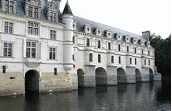|
From Le Havre, the tidal section of the river goes to well beyond
Rouen and ocean-going vessels can get 120km down from the sea to Rouen where they can
dock. The River Seine is dredged and commercial riverboats can use the river for
560km from its mouth.
Beyond Rouen there is a section that has 4 large multiple locks until the mouth of the
River Oise. There are 2 more locks and at Suresnes this lifts the vessels to the
level of the River Seine in Paris, which is where
the River Marne is located.
Until locks were installed in the 1800's to artificially raise the levels of the this
river, the levels did fluctuate, but today, the depth is tightly controlled and the entire
width of the river between the built-up banks on either side is normally filled with
water.
When Paris prospered through extensive river trading and expanded to the Left Bank in the
days of the Roman Empire, the Seine became a great commercial artery, which was linked by
canals to the River Loire, River Rhine, and the River Rhone.
Tourists and travellers will notice the many splendid bridges, which span the River Seine,
some of them several centuries old, and the oldest of these is the Pont-Neuf, whose first
stone was laid in 1578 by Henri III in the presence of the Queen Mother, Catherine de
Medicis.
The newest bridge called the Pont Charles de Gaulle was completed in the summer of 1996 to
accommodate the ever-increasing influx of traffic, especially with the new stadium.
The Seine, is without a doubt the best-known French
river in France and travels from Dijon in the Alps, through to Paris, which it cuts in
half, and then onto Le Havre, where it meets the English Channel.
This divide by the River Seine through Paris
is what gives the city its distinct, geographic division. For instance, the Eiffel Tower and the Musee
d'Orsay are on the south bank, whilst the Louvre,
Grand Palais, and the Concorde can be found on the north bank. In the centre of
Paris on the Ile de la Cite in the middle of the Seine River, you will find the Notre Dame Cathedral among other monuments.
And where the river forks in the centre of Paris it creates two small islands, which are
called the Ile de la Cite and the Ile Saint-Louis, also the River Seine is one of Europe's
great historical rivers, that attract tourists from all around the world.
|
|



